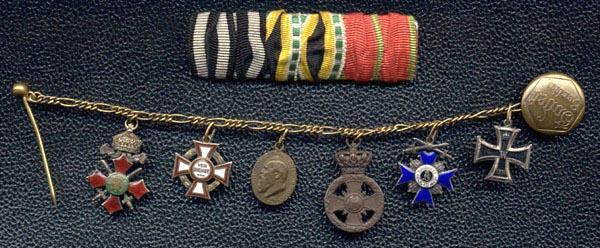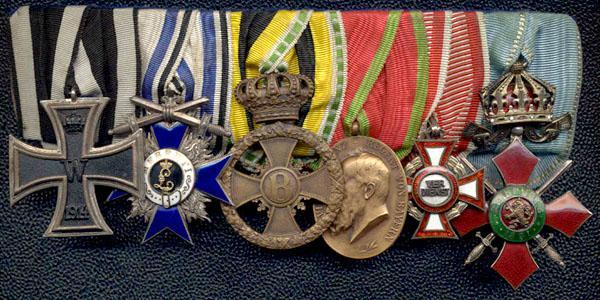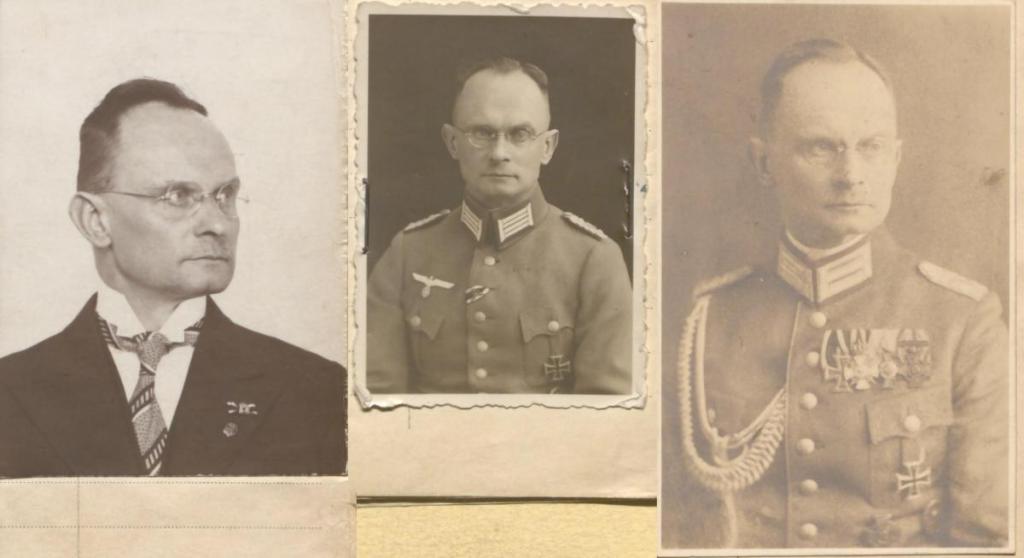-
Posts
4,908 -
Joined
-
Last visited
-
Days Won
97
Content Type
Profiles
Forums
Blogs
Gallery
Events
Store
Everything posted by Dave Danner
-
IR 88 was transferred to Trier in late 1939, but not everyone who was in theater during the Sitzkrieg received the medal. Unfortunately, the German Army was bad about listing this award. It was not considered a war decoration, so it was not listed in officer Beurteilungen during the war. He was wounded on 10.11.1914, so yes to the VAs.
-
The list is somewhat hard to follow as the order is a bit random. Here is what I have for wartime awards, sorted by the level of the state (kingdom, grand duchy, duchy, principality, free city, then foreign states) and alphabetically within each category. The award dates are given where known. "VOB" refers to the date of publication in the Verordnungsblatt des Königlich bayerischen Kriegsministeriums, generally for those awards where the actual award date is unknown. There are also minor discrepancies in some of the award dates in different sources. • Königlich Bayerischer Militär-Max-Joseph-Orden, Großkreuz (26.8.1914) • Königlich Bayerischer Militär-Verdienstorden, Schwertern zum Großkreuz (10.12.1917) • Königlich Preußisches Eisernes Kreuz 2. Klasse (16.10.1914) • Königlich Preußisches Eisernes Kreuz 1. Klasse (16.10.1914) • Königlich Preußischer Orden "Pour le mérite" (22.8.1915) • Königlich Preußischer Orden "Pour le mérite", Eichenlaube dazu (20.12.1916) • Königlich Preußischer Hausorden von Hohenzollern, Schwertern zum Großkomturkreuz (23.12.1917) • Königlich Preußischer Hausorden von Hohenzollern, Stern zum Großkomturkreuz mit Schwertern (23.3.1918) • Königlich Sächsischer Militär-St. Heinrichs-Orden, Ritterkreuz (23.11.1914) • Königlich Sächsischer Militär-St. Heinrichs-Orden, Kommandeur 2. Klasse (9.6.1915, VOB 21.8.1915) • Königlich Sächsischer Militär-St. Heinrichs-Orden, Kommandeur 1. Klasse (4.1.1917) • Königlich Sächsischer Militär-St. Heinrichs-Orden, Großkreuz (7.5.1918) • Königlich Württembergischer Militärverdienstorden, Großkreuz (2.12.1914) • Großherzoglich Badischer Militär-Karl-Friedrich-Verdienstorden, Großkreuz (12.1.1915) • Großherzoglich Hessisches Allgemeines Ehrenzeichen "Für Tapferkeit" (VOB 21.8.1915) • Großherzoglich Mecklenburg-Schwerinsches Militärverdienstkreuz 2. Klasse (VOB 21.8.1915) • Großherzoglich Mecklenburg-Schwerinsches Militärverdienstkreuz 1. Klasse (VOB 21.8.1915) • Großherzoglich Sächsischer Hausorden der Wachsamkeit oder vom Weißen Falken, Großkreuz mit Schwertern (1917) • Herzoglich Anhaltischer Orden Albrecht des Bären, Großkreuz mit Schwertern (VOB 21.8.1915) • Herzoglich Anhaltisches Friedrichkreuz (VOB 21.8.1915) • Herzoglich Braunschweigisches Kriegsverdienstkreuz 2. Klasse (VOB 21.8.1915) • Herzoglich Sachsen-Ernestinischer Hausorden, Schwertern zum Großkreuz (2.4.1915) • Herzoglich Sachsen-Meiningsches Ehrenkreuz für Verdienst im Kriege (29.9.1915) • Fürstlich Hohenzollernscher Hausorden, Schwertern zum Ehrenkreuz 1. Klasse (20.1.1915, Kgl. preuß. nachträgliche Genehmigung am 24.4.1917) • Fürstlich Lippisches Kriegsverdienstkreuz (7.6.1915) • Fürstlich Lippisches Kriegsehrenkreuz für heldenmütige Tat (7.6.1915) • Fürstlich Lippischer Hausorden des Ehrenkreuzes, Großkreuz mit Schwertern (13.12.1917) • Bremisches Hanseatenkreuz (9.11.1915) • Hamburgisches Hanseatenkreuz (19.10.1915) • Lübecksches Hanseatenkreuz (2.11.1915) • K.u.k. Österreich-Ungarisches Militärverdienstkreuz 1. Klasse mit der Kriegsdekoration 1. Klasse (VOB 6.6.1915) • K.u.k. Österreich-Ungarisches Große Militärverdienstmedaille (22.8.1917) • Großherrlich Osmanische Kriegsmedaille ("Eiserner Halbmond") (VOB 26.2.1916) • Großherrlich Osmanische Silberne Imtiaz-Medaille mit Säbeln (VOB 26.2.1916) • Großherrlich Osmanische Goldene Imtiaz-Medaille mit Säbeln (VOB 26.2.1916) I do not know of an award of swords to Rupprecht's prewar WK1 or OV1mKette.
-
Other known award dates: 31.01.1918 Königlich Preußischer Hausorden von Hohenzollern, Ritterkreuz mit Schwertern 26.06.1940 1939 Spange zum Eisernen Kreuze 2. Klasse 25.06.1941 1939 Spange zum Eisernen Kreuze 1. Klasse 08.11.1941 Verwundetenabzeichen in Silber 10.01.1942 Deutsches Kreuz in Gold 20.08.1942 Infanterie-Sturmabzeichen 07.09.1942 Medaille "Winterschlacht im Osten 1941/42" He did not have the Wehrmacht Dienstauszeichnung, as he was a reserve officer. From where do you have him receiving the Deutsches Schutzwallehrenzeichen? He is not wearing it in the photo above, which appears to date from 1942 after the award of the DKiG but before the award of the Ostmedaille.
-
The Rufname is "Johann Albert" Known awards: 21.07.1914 Großherzoglich Mecklenburgischer Greifenorden, Ritterkreuz 01.10.1914 1914 Eisernes Kreuz 2. Klasse 16.09.1915 Herzoglich Sachsen-Meiningsches Ehrenkreuz für Verdienst im Kriege 20.07.1916 1914 Eisernes Kreuz 1. Klasse 12.06.1917 Königlich Bulgarischer Alexanderorden, Ritterkreuz [mit Schwertern] xx.xx.1917 Großherrlich Osmanische Kriegsmedaille ("Eiserner Halbmond") 03.06.1918 Verwundetenabzeichen in schwarz 01.01.1935 Ehrenkreuz für Frontkämpfer 02.10.1936 Wehrmacht (Heer) Dienstauszeichnung 4. bis 2. Klasse 28.05.1940 1939 Spange zum Eisernen Kreuze 2. Klasse 17.06.1940 1939 Spange zum Eisernen Kreuze 1. Klasse 30.01.1942 Kriegsverdienstkreuz 2. Klasse mit Schwertern Inexplicably, he is in the list of ÖM3K recipients as a Hptm.i.G., Heeresgruppe Kiew, but it is not included in his file, nor in the Stammliste of the GFR. He also is not wearing it on the enlarged version of the Feldspange below. Note also that his file does not list swords to his BA5, nor are there any on the ribbon, but as a wartime award to a serving officer, it seems like there should have been swords.
-

heer Viebahn, Johann-Albert von
Dave Danner replied to tompress's topic in Germany: All Eras: Signature Database
From his Personalakte: "gem. Schreiben d. I.R. 29 v. 24.6.38 Rufn.: 'Johann Albert'" The Schreiben below. He may have gone by "Hans Albert" for a while, but reverted to his official birth name. His birth certificate has "Johann Albert Hermann Gotthilf". -
It's not Koenemann. He was a former IR 112 officer and had the Zähringen Lion and Baden's Regierungsjubiläumsmedaille. Also, a correction to Daniel's list: Koenemann was not Otto, but Erwin Dietrich Egon, *3.5.1866 in Berlin, †18.7.1935 in Nördlingen. Ottilie, Schiemann, Szillinsky and Wittmann can also be ruled out by other decorations. I am not 100% certain, but I believe that Roeder is Karl v. Roeder (1873-1945), the later Generalmajor z.V., who was a Maj.z.D. attached to the stellv. Generalstab der Armee in 1918. If so, he can also be ruled out by other decorations.
-
The OLt.d.R.a.D. Becker in FAR 21 who received the HOH3X on 6.7.1918, gazetted in the MWB on 3.9.1918, was Leopold. He also received the ÖM3K. According to Schlachten des Weltkrieges, he led 2./FAR 21 at Isonzo where it was attached to an Austro-Hungarian formation. I am not 100% certain, but I believe he is Dr.jur. Leopold Richard Becker, *8.8.1880 in Breslau, who was "schwer verwundet" in mid-1918 (Verlustliste v. 28.6.18) as an Oberleutnant. His promotion to Dr.jur. was on 31.7.1906 from the Universität Breslau and he was a Rechtsanwalt in Breslau and Neumarkt in Schlesien. I am also not 100% certain, but I believe this makes him the Lt.d.R. in FAR 6 with a Patent of 19.2.10, separated in 1912/13 and promoted to OLt.d.R.a.D. on 5.12.15 while with the Artillerie-Munitions-Kolonnen of the VI. Armeekorps.
-
07.11.1914 Königlich Sächsischer Militär-St. Heinrichs-Orden, Ritterkreuz 15.10.1915 Königlich Sächsischer Verdienst-Orden, Komturkreuz 2. Klasse mit Schwertern 01.11.1916 Königlich Sächsischer Albrechts-Orden, Komturkreuz 1. Klasse mit Schwertern 24.10.1917 Königlich Sächsischer Militär-St. Heinrichs-Orden, Komturkreuz 2. Klasse 26.09.1914 Königlich Preußisches Eisernes Kreuz 2. Klasse 31.12.1914 Königlich Preußisches Eisernes Kreuz 1. Klasse 24.03.1917 Königlich Preußischer Roter Adler-Orden 2. Klasse mit Schwertern 26.09.1917 Großherzoglich Mecklenburg-Schwerinsches Militärverdienstkreuz 2. Klasse 10.08.1915 Herzoglich Braunschweigisches Kriegsverdienstkreuz 2. Klasse 12.04.1917 Fürstlich Schaumburg-Lippisches Kreuz für Treue Dienste 1914 31.10.1915 K.u.k. Österreich-Ungarisches Militärverdienstkreuz 2. Klasse mit der Kriegsdekoration 2. Klasse
-
Regarding the other as yet unidentified Lts.d.R. Hansen, there were two in the GRSB (Edwin and Harald) and two in IR 163, so narrowing them down may not be possible. I have no idea about IR 464. It was formed by contributions from many IX.AK units (IR 84, IR 85, FR 86, GR 89, IR 162, IR 163, RIR 31, RIR 86) so there may be too many possibilities.
-
I don't know if he's already been found, but the Hauptmann Lehmann in RIR 7 who received the HOH3X in January 1917 was Kurt, *1.4.1875 in Cottbus; Hauptmann, IR 154 (Pat. 1.10.12), 18.8.18 Major, 1918 in Gefangenschaft als Kdr. I./RIR 7. RIR 7 was a Tochterformation of GR 7 and IR 154, which were both in the 18. Infanterie-Brigade. Kurt Lehmann entered IR 14 as a Portepée-Fähnrich on 15.12.1894, so he also had the Centenary and likely received the Dienstauszeichnungskreuz after returning from captivity. No other known Landesorden for this Prussian officer in Prussian regiments. Since it's a common name, not to be confused with Hptm. Kurt Lehmann from IR 59 or Hptm. Curt Lehmann from FAR 5.
-
Bingel is Otto Hermann Karl Gustav Josef, *6.9.1869 in Lollar, Gießen, †9.9.1943 in Berlin-Charlottenburg. He was a Fürstlich Solms-Braunfels'scher Rentmeister. There are familial connections between the then-Fürst and Italy (his wife and mother), which might explain the JK5. No connection to any of the other decorations seems apparent. I have nothing on Richert other than that in the 1911 ranklist of reserve/Landwehr officers, he is listed as a Gefängnis-Inspektionsassistent in Charlottenburg. No Richert with that occupation is listed in the 1914 and 1915 Berlin address books; the closest is Albert Richert, listed as a Polizeibeamter.
-
Miethner and Sichler both received the HOH3X. Maybe, as suggested above, there are Navy candidates. Otherwise, a recalled a.D. officer who might be hard to find if he received the foreign orders after leaving the Army. As for the war decorations, Oldenburg and Braunschweig may point to a X. Armeekorps connection.
-
Range, Johann Friedrich Heinrich *1.10.1887 in Barth, Franzburg †12.3.1945 in Stolp in Pommern xx.12.1914 leicht verwundet bei Carlepont als Offz.-Stellv., 8./GR 89 27.1.1915 Lt.d.R. (Rostock) d. GR 89 31.12.1915 Komp.Offz., 8./GR 89 (laut Stellenbesetzung) 01.7.1916 Komp.Fhr., 10./GR 89 (laut Stellenbesetzung) 23.7.1916 Komp.Fhr., 12./GR 89 (laut Stellenbesetzung) xx.xx.1917 schwer verwundet (VL 975/29.10.17) 10.1.1918 nicht in der GR 89 Stellenbesetzung, vermutlich noch beurlaubt wegen Verwundung 10.7.1918 Komp.Fhr., 6./GR 89 (laut Stellenbesetzung) 4.6.1918 verheiratet mit Maria Anna Karoline, geb. Klissing, *7.5.1886 in Barth 19.7.1915 Ghzgl. Meckl.-Strelitzsches Kreuz für Auszeichnung im Kriege 25.1.1917 Ghzgl. Meckl.-Schwerinsches Militärverdienstkreuz 2. Kl. (Tag der Veröffentlichung im Regierungsblatt) 16.08.1917 Ghzgl. Meckl.-Schwerinsches Militärverdienstkreuz 1. Kl. (Tag der Veröffentlichung im Regierungsblatt) 8.11.1917 Kgl. Preußischer Hausorden von Hohenzollern, Ritterkreuz mit Schwertern The 1919 Mecklenburg Census lists one son, born in 1919. There may have been other children later.
-
It seems likely. The Determann who received the HOH3X on 28.10.1918 was with GGR 2. Hans is listed as the Nachrichtenoffizier of the III. Bataillon of RIR 259 in the last Stellenbesetzung of 25.5.1918. When RIR 259 was dissolved in August 1918, its men were allocated among the regiments of the 2. Garde-Infanterie-Division. Although the III. Bataillon went mostly to GGR 1, the GGR 2 regimental history places Determann with 2./GGR 2 (Komp.Offizier and stellv. Komp.Führer) in September 1918. Determann, Hans Heinrich Erich *27.8.1892 in Hannover, †26.4.1969 in Bad Sachsa His brother Karl died of typhus on 6.4.1917 as an Oberarzt d.R. in Landwehr-Feldlazarett Nr. 10
-
Preißler, Otto Adolf Hermann *17.3.1892 in Ricklingen, Linden †10.10.1959 in Garmisch-Partenkirchen HOH3X on 27.9.1918 as a Lt.d.R. in Kürassier-Regiment Nr. 5, though he is listed there as "Preisler." According to the casualty list, he was Führer of the 2. M.G.-Eskadron of KR 5. The 1929 Charlottenburg Eheregister gives his occupation as "akademischer Maler." His BAMA Personalakte lists his final rank as Oberstleutnant (Heer), but as he was not an active officer in the 1938/39 Stellenbesetzungen, I don't know if he was z.V. or d.R.
-
Aschoff, Albrecht Ludwig Wilhelm *11.4.1899 in Berlin †11.8.1972 in Bad Neuenahr 1930 Dr.jur. 30.09.1917 Leutnant, vorläufig ohne Patent * 01.10.1934 Hauptmann mit RDA vom 01.06.1934 (75) 01.02.1940 Major (86) 01.02.1942 Oberstleutnant (30) 01.06.1943 Oberst * He still didn't have a Patent as of the 1919 Dienstaltersliste, so I don't know what his final Patent may have ended up being. He commanded the II. Abteilung of Artillerie-Regiment 76 in Operation Barbarossa. He was taken prisoner in May 1943 while serving as Chef des Deutschen Wirtschaftstabes beim Oberbefehlshaber Tunisien. Known decorations: 26.10.1917 1914 Eisernes Kreuz 2. Klasse 20.11.1917 Fürstlich Lippisches Kriegsverdienstkreuz 10.04.1919 1914 Eisernes Kreuz 1. Klasse xx.xx.1935 Ehrenkreuz für Frontkämpfer 02.10.1936 Wehrmacht (Heer) Dienstauszeichnung 4. Klasse xx.xx.19xx 1939 Spange zum Eisernen Kreuze 2. Klasse xx.xx.19xx 1939 Spange zum Eisernen Kreuze 1. Klasse xx.xx.1942 Medaille "Winterschlacht im Osten 1941/42" xx.xx.19xx Kriegsverdienstkreuz 2. Klasse mit Schwertern xx.xx.19xx Kriegsverdienstkreuz 1. Klasse mit Schwertern xx.xx.19xx Allgemeines Sturmabzeichen 19.08.1941 Nennung im Ehrenblatt des Deutschen Heeres 25.05.1942 Deutsches Kreuz in Gold Also maybe one or more Italian awards.
-
I would imagine the EK2w was awarded relatively early in the war, say 1915. One of the main reasons for the creation of the Verdienstkreuz für Kriegshilfe is that the Prussians thought the value of the EK2w was being diminished by too many awards for Heimatverdienst. This would have entailed tearing up his pre-war ribbon bar, adding the EK2w and likely removing the Belgian order. By 1917, when given the choice of adding additional awards, perhaps rather than tear apart his existing large trapezoidal bar, he had a ribbon bar made with the now more in-style shorter ribbons. Here, by the way, is an example of a wartime ribbon bar never upgraded with later wartime awards:
-
Revisiting this topic several years later to add some new information as more sources have become available since the passing of gurus like George and Rick. I've no idea where the ribbon bar ended up, but perhaps its owner will appreciate the additions. First, one clarification: Hofrat Trzeciok was Eduard Gregor, born in 1869. He was the father of Dr. Eduard Hermann Trzeciok, born in 1901, who received his doctorate in 1924 and was the wissenschaftlicher Hilfsarbeiter in the later Berlin address books. So not technically a "Junior" but still his son. I've no idea the fate of the father. Trzeciok received permission to wear the GSF3b on 8.9.1911 and permission to wear the Officer's Cross of the Belgian Leopold Order on 8.11.1913. That award didn't make the ribbon bar since by that point Belgium was the enemy. Besides the Saxon Kriegsverdienstkreuz noted in the 1918 Court and State entry above, he also received later in 1918 the Anhalt Friedrichkreuz am grün-weißen Bande. I also have a note that he received the Württemberg Wilhelmskreuz mit Schwertern, but I can't find my source for that.







